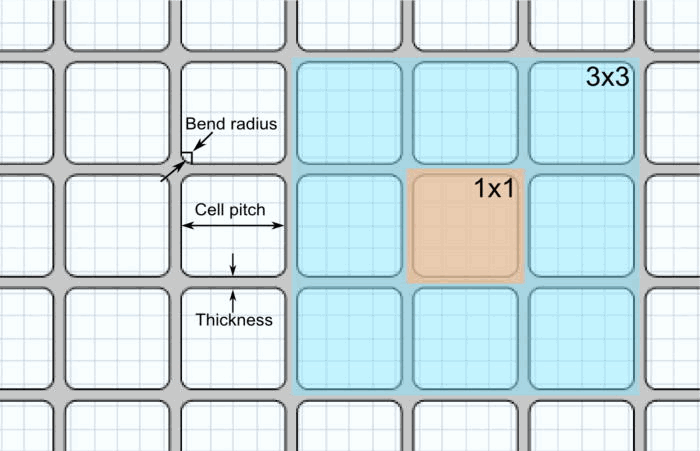Electrically charged wire meshes are used throughout science and engineering to guide, focus and analyse charged particles and may be found in areas as diverse as unmanned satellite propulsion systems, mass spectrometers and particle accelerators. Understanding particle motion is a necessity to optimise the performance of devices such as these. Researchers at the Cockcroft Institute have carried out extensive studies into mesh based systems to improve the understanding of the dynamics of charged particles which pass through them and have recently published the methodology and findings in the expert journal Physics of Plasmas.

Wire mesh drawn in Comsol Multiphysics. The mesh is defined by the cell pitch, wire thickness, and the bend radius. The colored boxes represent n × n cells which are used in cell convergence studies to approximate a full mesh.
Citation: Phys. Plasmas 23, 063110 (2016); http://dx.doi.org/10.1063/1.4953801
Accurate calculations of the complex electrostatic fields surrounding a charged mesh are pivotal to understand their effects on particle motion. Analytical solutions have been found utilising several assumptions; however, they limit the ability to be fully confident in the fields generated around a physical wire mesh and with a multi-mesh system it becomes even more complicated. To this end CI experts have used finite element solvers to accurately model a mesh and have been able to calculate highly precise potentials around the structure on a personal computer using the exact geometry of a physical mesh.
Simulation tools often used for these systems are black boxes as the user has little access or understanding into what codes are doing. For this reason an easy-to-use Matlab-Simulink code was developed which uses field values calculated by the finite element method to be able to fully simulate particles travelling through mesh based systems. This new code allows any initial distribution of particles to be simulated and as such gives the user greater freedom to understand particle dynamics using a mesh of any dimensions and with any potential applied. The Simulink framework allows changes to be made to the model to fit specific requirements with the option to use traditional script based algorithms. This code has been made freely available so that it may be used by anyone who wishes to use it to understand their mesh systems in greater detail.
L.J. Devlin, O. Karamyshev and C.P.Welsch: ‘Charged particle tracking through electrostatic wire meshes using the finite element method’, Physics of Plasmas (Vol.23, Issue 6) DOI: 10.1063/1.4953801
